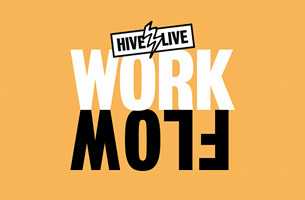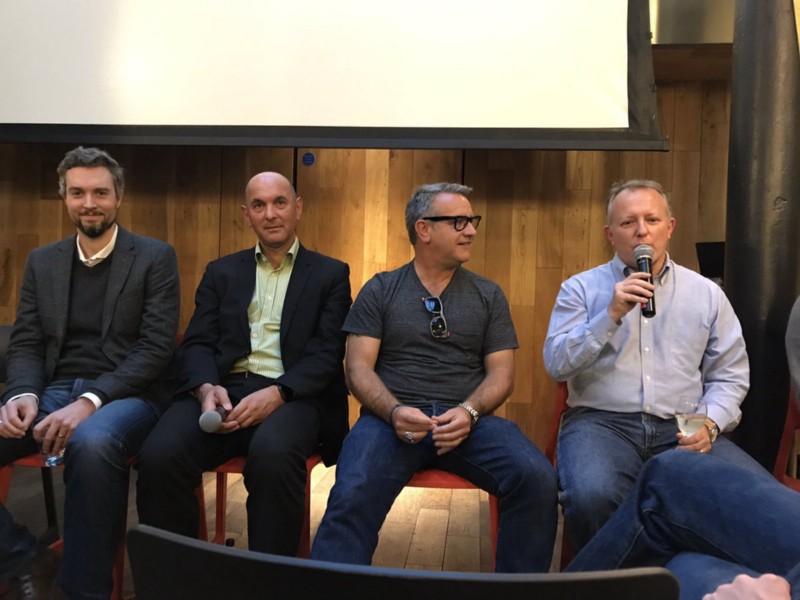
HiveLive 2: Brands Are The Boss, But Creative is Still King

- Pat Murphy, founder of MCA, spoke about making tight budgets work.
- Luke Hammersley, founder of Zebra Worldwide, shared why creativity is at the heart of localisation.
- Seenit’s COO, Nick Verkroost, shook things up with ideas from the frontline of innovative online social content.
- Moritz Wuttke, COO of Honeycomb, brought insights about the fast approaching world of programmatic.
- David Sanderson of Sky Adsmart, inspired with stories of how addressable TV is opening up opportunities for all sorts of brands.
- Matt Cooper founder of LBBonline, championed the best creative — and challenged those who were satisfied with less.
Increasingly, industry change is being driven by the client. How have you seen brands change their behaviour over the past couple of years, and what impact has that had on how you do business?
Pat Murphy, MCA: Since the financial crash in 2008, we’ve seen the rise and rise of procurement. There’s a big challenge to find procurement champions of great creative, and striking the right balance between cost and creative.
More recently, there’s also been a shift in the appetite of marketers to work directly with independents. Budgets haven’t gone up, but brands need to produce more, so there’s a fantastic opportunity for independent suppliers who want to build relationships directly with brands.
How have we adapted? As a business we’ve had to be flexible. Everyone thinks we’re about cost control, but we’re not — cost control in the traditional sense is dead. Instead, we find ways to get the maximum out of a budget. It’s about getting the biggest bang for your buck.

Nick Verkroost, David Sanderson, Matt Cooper and Pat Murphy
Moritz Wuttke, Honeycomb: In Programmatic advertising online, you’re overlaying an audience onto a media schedule. Third party data — cookies, buying patterns, demographics etc — means you can target the media in a way that’s just not possible on linear TV today, with the exception of Adsmart. But in just five years you’ll be able to buy programmatic or addressable advertising in 80% of all channels.
Nick, this is part of what you guys are doing. Who have been the early adopters?
Nick Verkroost, Seenit: Corporates. They’re not using it to talk about the brand publicly, but how the brand resonates internally. They’re turning the camera on the employees to reveal and reinforce the brands’ values: they want the message to come from the employees, not the central marketing team. That’s a trend.
Marketing departments are typically well funded, but internal comms and recruitment departments have a fraction of that budget to play with. Internal comms teams tend to be much more prepared to carry the burden of producing content, usually because they’ve never had the luxury of working with an agency: So everything is organic: they do it all themselves.
So what have we seen change? Brands are recognising that they can do a themselves without having to bring in an agency. We’re now educating marketing teams to edit video — we never would have been able to do that three years ago. That’s a trend reflected in the wider industry: with budget cuts, people are refining down who their partners will be.
How are agencies addressing new opportunities that are a result of the changes in the market?
Matt Cooper, LBB Online: Agencies are struggling — the industry is the Wild West at the moment. I think brands don’t know what they want, where to put it or who should make it. More people are making more stuff than ever — lots of the agencies are starting to create their own production areas to take on more stuff. And most of that stuff people don’t want to watch. That’s a real problem.
People aren’t just skipping ads, they’re skipping brands. That’s a problem that agencies need to fix.
Pat Murphy: I avoid the ads, and I’m in the ad business! It should be all about creating experiences, not making TV ads that nobody is going to watch. Clients are looking at their agencies and thinking they should be doing a lot of that work themselves. But while they’re building in-house capabilities to do the easy stuff they still want to hire great creative. They still need great creative champions and directors. The agencies that aren’t recruiting this talent are shooting themselves in the foot right now. Will the agency model survive 2017? Momentum is building towards moving away from the traditional agency model.
Are all the media channels: traditional TVC, online, addressable, social media — being used effectively, or is the consumer just cheesed off by the constant barrage of content?
Luke Hammersley: Collateral can be a really rich, inspiring, educational thing that people enjoy consuming on whatever medium, but it has to be really good. Yes, there is too much crap — the brands need to take responsibility.
Brands have a PR agency, a social media agency, a creative agency, a digital agency, and a marketing team — that’s too many silos. The client needs to step up and take responsibility for owning their content strategy — not rely on agencies they can then fire for not being good enough. They’ve got to understand their audience, and their data — then they can talk to their customers in an informed way.

“Brands need to man up!” Luke Hammersley from Zebra Worldwide entertaining MCA’s Pat Murphy
We talk about data overnight, insight for breakfast, strategy and creative by lunchtime, production in the afternoon, implementation in the evening, and data again overnight. That’s the way you’ve got to think — to bring all that stuff and the agencies together. It’s too easy to operate in a silo and then point fingers. Frankly it’s bollocks. Brands need to man up and take responsibility.
David Sanderson: But the idea of terrible content and disengaged audiences switching off just isn’t true on TV. 10 years ago, web penetration was under 10%, TV viewing averaged 3.5 hours a day. Today TV viewing is the same, and internet penetration has doubled.
So the rubbish content we’re talking about isn’t on TV. And if people choose to download and fast forward, that’s fine in the Adsmart world, because brands will only be charged if people see their ads. I ask real people to think of a TV ad that’s worked for them. Everyone can. Then I ask if they’ve seen a Facebook or press ad that’s stayed with them. Nobody has. And these are the people claiming they’re skipping the TV ads.
Does addressable advertising complement the mix of media, or is it a disruptive replacement?
David Sanderson: TV is at the beginning of every campaign: it’s where the ideas are landed. The message is then supplemented and amplified by everything else a brand does. So a proper good, integrated advertising campaign should include TV.
Credit Suisse recently said that by 2030, programmatic ad spend will increase to 100bn dollars a year. This flies in the face of the idea of people avoiding advertising.
Moritz Wuttke: TV can be more targeted, so it is taking advertising dollars from online, which has proven to be not so effective. Data will be increasingly important — you can analyse so much about customer behaviour with Programmatic tech. Honeycomb has just introduced fingerprinting data for linear TV which allows us to give data back to the advertiser just 30 minutes after an ad has been broadcasted. Until now, that sort of data was only available online. It’s a huge opportunity for TV, but it’s also a challenge for engagement: creating the right ad, A/B testing. For example, Mini made 30 different variations of the same ad for geographic and social targeting.
Nick Verkroost: We’ve got Matt saying “nobody’s watching the ads.” then Credit Suisse saying ad spend on TV is going to double. This really shows the problem agencies are facing: there are different generations using different type of technology, and engaging with content, brands, and TV shows in different ways. Creating a unified ad campaign to target that entire base is now almost impossible. Depending on which demographic you’re talking about, all of these points are true. But all of these points are also completely incorrect.
So what does the new age agency need to look like if it’s going to be successful all across that demographic base? Or do brands have to pick a segment, then build credibility, rapport and awareness, cross their fingers, and let that generation mature, and then focus on the next one?
Matt Cooper: We have to start creating stuff that the people you’re trying to sell to actually want to watch. There are great examples: Vans are doing brilliant stuff — with channels of really great content. But at the moment, lots of people are continuing to churn out crap, then asking why it’s not driving sales. Facebook is saying we need to start creating six second content because people are skipping it after six seconds. They’re not skipping it because it’s long, they’re skipping it because it’s crap.
David Sanderson: Three years ago, people leaving during ad breaks was about 10%. But when we started to show more relevant ads, this dropped to just 5%. We’re showing ads that people are happy to see because they’re more pertinent. People perk up in ad breaks — if it’s relevant.
There are loads of opportunities from the disruption and fragmentation in the industry. But what is the role of the traditional creative agency?
Nick Verkroost: Typically, there’s someone in the brand who knows what they want to do. And creative agencies tend to get a bit feisty when we come in and offer new tech to help them realise those ideas. But there’s still a gap between the the brand’s ambition and the execution of the ideas. They still need the support of the industry to bridge that gap.
Pat Murphy: Agencies‘ role going forward will be great ideas and strategy. That’s it. Everything else is up for grabs.
What’s the best example of an Adsmart campaign?
David Sanderson: Maclaren excluded 99.9% of the Sky customer base and only showed their ad to just 60K households who fit into a very small niche. Their sales went from six to ten a week — at £145K a car that’s a good return! At the other end, we ran a tiny campaign in the north east of England for a fostering agency. The ad cost £2K, the campaign £3k, they found a home for one child, and saved the local council £50K a year. Now that’s a brilliant return on investment.
Finally, in a shifting landscape, how do you maintain a culture which runs through a project, or your own businesses?
Luke Hammersley: You’re suggesting that without an agency the culture wouldn’t necessarily flow through? It comes back to the responsibilities of the client to take ownership and people working alongside each other a bit better.
Matt Cooper: It’s about getting the talent together early enough. Get the best talent together from the start to the end of the job, and then everyone shares responsibility.
Pat Murphy: A few years ago we tried to change the perception of MCA — trying to give the industry the sense that we’re on your side. You have to get the balance of cost and creativity right, because if you can help the agency get 1% more effectiveness, that pays for al the production cost. I’ve tried to install those values into my team.
Nick Verkroost: For us, culture is everything. People don’t buy from platforms, they buy from people. So it’s about personal relationships with people who get round the table. They buy from you because you are an expert in your industry, or that you care about that business more than anyone. At the core of the culture we are building at Seenit is that a great idea can come from anywhere. Some of the most creative people are the newest ones in our business — and they’re the ones pushing the company forward. That’s the culture we’re trying not to lose.











